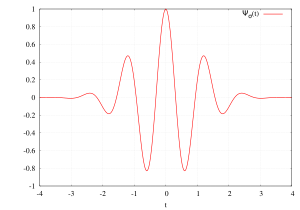Wavelet facts for kids
A wavelet is a special mathematical tool. It helps us break down complicated information, like sounds or images, into smaller, simpler pieces. Think of it like taking a big puzzle and separating it into many tiny, easy-to-understand parts.
This process is called a wavelet transform. It's super useful in many areas, especially when working with signals. Imagine looking at something with a magnifying glass. A wavelet lets you 'zoom in' on different parts of a signal. This way, you can see details that might be hidden when looking at the whole picture. The shape of the wavelet decides what kind of details you can see.
What is a Wavelet?
The word "wavelet" means "small wave." It was first used in the early 1980s by two French scientists, Jean Morlet and Alex Grossman. They used the French word "ondelette," which means the same thing. Later, it was translated into English as "wavelet."
A wavelet is a mathematical function, which is like a rule that connects numbers. For wavelets to be useful in real life, they need to follow some important rules:
- They must have a limited amount of energy. This means they don't go on forever and have a clear start and end.
- They must have an average value of zero. This means they wiggle up and down around a central line.
The Mother Wavelet
Every wavelet family starts with a main wavelet called the mother wavelet. Think of it as the original pattern. From this mother wavelet, we can create many other wavelets by changing two things:
- Shifting: We can move the wavelet along the signal, like sliding a magnifying glass across a picture. This helps us look at different parts of the signal.
- Scaling: We can stretch or squish the wavelet. Stretching it makes it wider, like zooming out to see the bigger picture. Squishing it makes it narrower, like zooming in to see tiny details.
By shifting and scaling the mother wavelet, we can analyze signals at different times and at different levels of detail. This makes wavelets very powerful for understanding complex information.
How Wavelets Are Used
Wavelets are used in many cool ways, including:
- Image compression: They help make image files smaller without losing too much quality. This is how JPEGs work!
- Noise reduction: They can clean up noisy signals, like making a blurry photo clearer or removing static from an audio recording.
- Medical imaging: They are used in things like MRI scans to get clearer pictures of the inside of the body.
- Earthquake analysis: Scientists use them to study seismic waves and understand earthquakes better.
Wavelets are a fantastic tool for anyone who needs to analyze and understand complex data.
Images for kids
See also
 In Spanish: Ondícula para niños
In Spanish: Ondícula para niños



